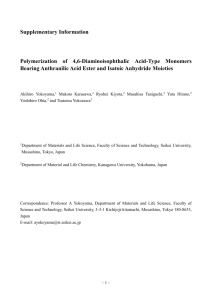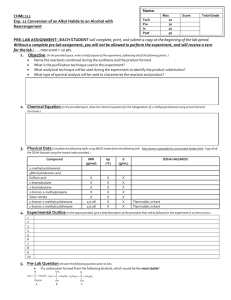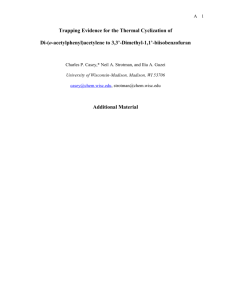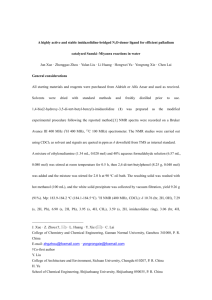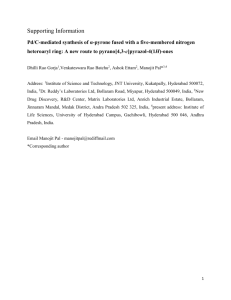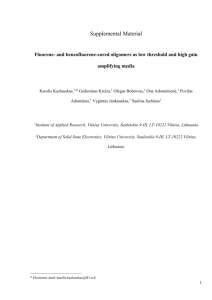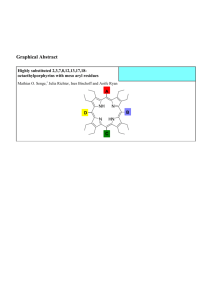BiMIm - Royal Society of Chemistry
advertisement
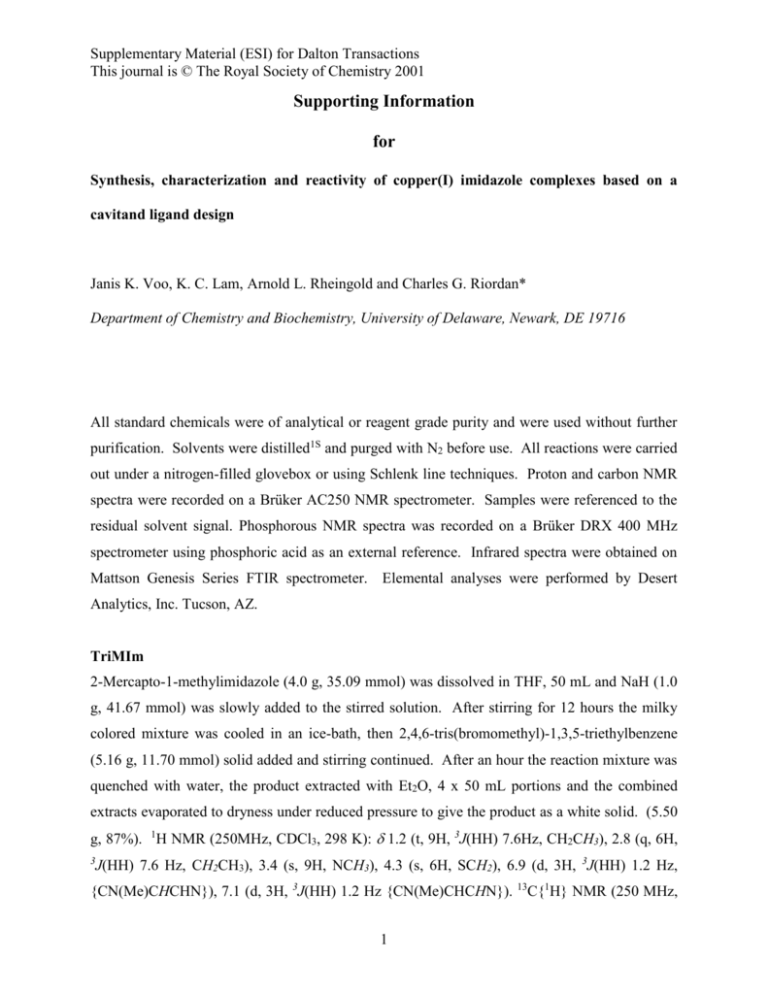
Supplementary Material (ESI) for Dalton Transactions
This journal is © The Royal Society of Chemistry 2001
Supporting Information
for
Synthesis, characterization and reactivity of copper(I) imidazole complexes based on a
cavitand ligand design
Janis K. Voo, K. C. Lam, Arnold L. Rheingold and Charles G. Riordan*
Department of Chemistry and Biochemistry, University of Delaware, Newark, DE 19716
All standard chemicals were of analytical or reagent grade purity and were used without further
purification. Solvents were distilled1S and purged with N2 before use. All reactions were carried
out under a nitrogen-filled glovebox or using Schlenk line techniques. Proton and carbon NMR
spectra were recorded on a Brüker AC250 NMR spectrometer. Samples were referenced to the
residual solvent signal. Phosphorous NMR spectra was recorded on a Brüker DRX 400 MHz
spectrometer using phosphoric acid as an external reference. Infrared spectra were obtained on
Mattson Genesis Series FTIR spectrometer. Elemental analyses were performed by Desert
Analytics, Inc. Tucson, AZ.
TriMIm
2-Mercapto-1-methylimidazole (4.0 g, 35.09 mmol) was dissolved in THF, 50 mL and NaH (1.0
g, 41.67 mmol) was slowly added to the stirred solution. After stirring for 12 hours the milky
colored mixture was cooled in an ice-bath, then 2,4,6-tris(bromomethyl)-1,3,5-triethylbenzene
(5.16 g, 11.70 mmol) solid added and stirring continued. After an hour the reaction mixture was
quenched with water, the product extracted with Et2O, 4 x 50 mL portions and the combined
extracts evaporated to dryness under reduced pressure to give the product as a white solid. (5.50
g, 87%). 1H NMR (250MHz, CDCl3, 298 K): 1.2 (t, 9H, 3J(HH) 7.6Hz, CH2CH3), 2.8 (q, 6H,
3
J(HH) 7.6 Hz, CH2CH3), 3.4 (s, 9H, NCH3), 4.3 (s, 6H, SCH2), 6.9 (d, 3H, 3J(HH) 1.2 Hz,
{CN(Me)CHCHN}), 7.1 (d, 3H, 3J(HH) 1.2 Hz {CN(Me)CHCHN}). 13C{1H} NMR (250 MHz,
1
Supplementary Material (ESI) for Dalton Transactions
This journal is © The Royal Society of Chemistry 2001
CDCl3, 298 K): 16.2, 22.6, 33.1, 33.5, 122.4, 129.5, 130.6, 141.2, 143.8. (Found: C, 59.7; H,
6.88; N, 15.4. C27H36N6S3 requires C, 60.0; H, 6.71; N, 15.5%). ESI-MS (CH3OH) m/z 541.2
([M+H]+).
BiMIm
2-Mercapto-1-methylimidazole (6.56 g, 57.46 mmol) was dissolved in THF, 100 mL then NaH,
(1.38 g, 57.50 mmol) slowly added to the stirred solution. After 12 hours the milky colored
reaction mixture was cooled in an ice-bath, and 2,4-bis(bromomethyl)-1,3,5-triethylbenzene
(10.0 g, 28.75 mmol) solid, was added. The suspension was stirred for an additional two hours
then quenched with water. The product was extracted with CHCl3, 200 mL, and the solvent
removed under reduced pressure, to obtain an off white solid. (7.37 g, 62%).
1
H NMR (250
MHz, CDCl3, 298 K): 1.2 (m, 9H, CH2CH3), 2.7 (m, 6H, CH2CH3), 3.4 (s, 6H, NCH3), 4.3 (s,
4H, SCH2), 6.9 (s, 1H, CH), 7.0 (d, 2H, 3J(HH) 1.2 Hz, {CN(Me)CHCHN}), 7.1 (d, 2H, 3J(HH)
1.1 Hz, {CN(Me)CHCHN}). 13C{1H} NMR (250 MHz, CDCl3, 298 K): 15.6, 16.5, 22.3, 26.0,
33.2, 33.3, 122.5, 127.2, 129.7, 129.8, 141.7, 143.5, 143.7. (Found: C, 63.6; H, 7.22; N, 13.2.
C22H30N4S2 requires C, 63.7; H, 7.29; N, 13.5%).
[(TriMIm)Cu]BF4
To a stirred solution of [Cu(CH3CN)4]BF4 (0.5 g, 0.16 mmol) in CH2Cl2, 40 mL was added a
solution of TriMIm (0.86 g, 0.16 mmol) in CH2Cl2, 20 mL at 25 °C. The colorless solution was
stirred overnight then the solvent removed under vacuum, resulting in precipitation of the
product as a white solid. (0.95 g, 87%). X-ray quality crystals were grown by slow evaporation
of a concentrated CH2Cl2 solution. 1H NMR (250 MHz, CD2Cl2, 298 K): 0.9 (t, 9H, 3J(HH)
7.6 Hz, CH2CH3), 1.7 (br, 6H, CH2CH3), 3.8 (br, 6H, SCH2), 3.9 (s, 9H, NCH3), 6.8 (d, 3H,
3
J(HH) 1.1 Hz, {CN(Me)CHCHN}), 7.2 (d, 3H, 3J(HH) 1.3 Hz, {CN(Me)CHCHN}).
13
C{1H}
NMR (250 MHz, CD3CN, 298 K): 16.1, 22.1, 34.3, 35.9, 125.3, 131.6, 132.7, 139.8, 144.1.
(Found: C, 47.0; H, 5.24; N, 12.2. C27H36CuN6S3BF4 requires C, 46.9; H, 5.25; N, 12.2%). ESIMS (THF) m/z 603.0 ([M–BF4]+).
2
Supplementary Material (ESI) for Dalton Transactions
This journal is © The Royal Society of Chemistry 2001
[(BiMIm)Cu(CH3CN)]BF4
To a stirred solution of [Cu(CH3CN)4]BF4 (3.20 g, 1.02 mmol) in MeCN, 75 mL was added a
solution of BiMIm, (4.23 g, 1.02 mmol) in MeCN, 25 mL at 25 °C. The colorless solution was
stirred overnight, then the solvent evaporated in vacuo, resulting in precipitation of a white solid.
(5.8 g, 95%). X-ray quality colorless, needle-like crystals were obtained by slow evaporation of
a concentrated CH2Cl2 solution. 1H NMR (250 MHz, CD2Cl2, 298 K): 0.9 (t, 3H, 3J(HH) 7.6
Hz, CH2CH3), 1.0 (t, 6H, 3J(HH) 7.4 Hz, CH2CH3), 1.9 (s, 3H, NCCH3), 2.1 (m, 6H, CH2CH3),
3.7(d, 2H, 2J(HH) 13.9 Hz, SCH2), 3.8 (s, 6H, NCH3), 4.1 (d, 2H, 2J(HH) 13.9 Hz, SCH2), 6.7 (s,
1H, CH), 6.8 (d, 2H, 3J(HH) 1.6 Hz, {CN(Me)CHCHN}), 7.3 (d, 2H, 3J(HH) 1.4 Hz,
{CN(Me)CHCHN}).
C{1H} NMR (250 MHz, CD2Cl2, 298 K) 2.2, 15.6, 16.5, 22.9, 25.9,
13
33.9, 36.1, 117.0, 126.3, 127.8, 130.1, 131.1, 140.9, 141.0, 143.9. (Found: C, 47.2; H, 5.39; N,
11.5. C24H33N5S2CuBF4 requires C, 47.6; H, 5.49; N, 11.6%).
Reaction of [(BiMIm)Cu(CH3CN)]BF4 with CO
Carbon monoxide was bubbled through a solution of [(BiMIm)Cu(CH3CN)]BF4 (4.55 g, 0.50 M)
in 15 mL of CH2Cl2 at 0 °C. The reaction was followed by in situ FT-IR using a ReactIR™
1000 and ReactIR MP™ Mobile Reaction Analysis System. Spectra were recorded every 10
minutes for 3.5 hours. The experiment was repeated with 13CO replacing 12CO, and the reaction
monitored for 2 hours. IR: max/cm–1 2073, 2108 (CO); 2026, 2061 (13CO).
13
C{1H} NMR (250
MHz, CD2Cl2, 273 K) 2.2, 15.0, 17.0, 22.1, 25.4, 30.9, 33.1, 34.4, 35.4, 36.7, 117.4, 123.9,
124.2, 125.8, 127.3, 128.3, 131.4, 140.3, 141.3, 143.1, 169.6.
Reaction of [(BiMIm)Cu(CH3CN)]BF4 with PMe3
To a stirred solution of [(BiMIm)Cu(CH3CN)]BF4 (1.5 g, 2.5 mmol) in acetone, 70 mL was
added a solution of PMe3, (0.19 g, 2.5 mmol) in THF, 10 mL at 25 °C. The colorless solution
was stirred overnight, then the solvent evaporated under vacuum, resulting in precipitation of a
white solid. (1.65 g, 93%). 1H NMR (250 MHz, (CD3)2CO, 298 K): 1.0 (m, 9H, CH2CH3), 1.3
(br, 9H, PCH3), 2.2 (br, 4H, CH2CH3), 2.5 (br, 2H, CH2CH3), 4.0 (s, 6H, NCH3), 4.2 (s, 4H,
SCH2), 6.7 (s, 1H, CH), 7.1 (d, 2H, 3J(HH) 1.5 Hz, {CN(Me)CHCHN}), 7.5 (d, 2H, 3J(HH) 1.5
Hz, {CN(Me)CHCHN}).
13
C{1H} NMR (250 MHz, CDCl3, 298 K): 15.4, 16.2, 21.9, 25.3,
29.4, 33.1, 35.2, 125.5, 126.7, 129.6, 129.9, 139.2, 141.6, 142.9.
3
31
P{1H} NMR (400 MHz,
Supplementary Material (ESI) for Dalton Transactions
This journal is © The Royal Society of Chemistry 2001
(CD3)2CO, 298 K) : –39.4 (q, 1J(Cu-P) 800 Hz).
(Found: C, 46.4; H, 6.14; N, 8.4.
C25H39N4S2CuBF4 requires C, 46.8; H, 6.13; N, 8.7%).
[BiMIm]Cu(NCS)
To a stirred solution of [(BiMIm)Cu(CH3CN)]BF4 (1.0 g, 1.7 mmol) in acetone, 100 mL was
added KSCN (0.16 g, 1.7 mmol) in acetone, 20 mL at 25 °C. The colorless solution gradually
turned cloudy as stirring continued overnight. The mixture was filtered through a Silica gel
column and the product precipitated by addition of diethyl ether. (0.70 g, 77%). 1H NMR (250
MHz, CDCl3, 298 K): 1.1 (t, 3H, 3J(HH) 7.6 Hz, CH2CH3), 1.2 (t, 6H, 3J(HH) 7.7 Hz,
CH2CH3), 2.3 (q, 2H, 3J(HH) 7.6 Hz, CH2CH3), 2.5 (q, 4H, 3J(HH) 7.6 Hz, CH2CH3), 3.6 (s, 6H,
NCH3), 4.1 (s, 4H, SCH2), 6.9 (s, 1H, CH), 7.0 (s, 2H, {CN(Me)CHCHN}), 7.1 (s, 2H,
{CN(Me)CHCHN}). IR (KBr): max/cm–1 2109 (CN).
(Found: C, 51.2; H, 5.33, N, 12.9.
C23H30CuN5S3 requires C, 51.5; H, 5.6; N, 13.1%).
[BiMIm]Cu(N3) Synthesis
To a stirred solution of [(BiMIm)Cu(CH3CN)]BF4 (1.0 g, 0.83 mmol) in acetone, 50 mL was
added KN3 (67 mg, 0.83 mmol) in MeOH, 30 mL at 25 °C. The solution gradually turned brown
and was stirred for 12 hours then the solvent removed under vacuum, resulting in precipitation of
the crude product. The residue was extracted with acetone, 20mL followed by solvent removal
to yield the pure product as a light brown solid. (0.21 g, 49%).
1
H NMR (250 MHz, CD3CN,
298 K): 0.9 (t, 3H, 3J(HH) 7.3 Hz, CH2CH3), 1.1 (t, 6H, 3J(HH) 7.8 Hz, CH2CH3), 2.1 (q, 2H,
3
J(HH) 8.0 Hz, CH2CH3), 2.2 (q, 4H, 3J(HH) 7.4 Hz, CH2CH3), 3.8 (s, 6H, NCH3), 4.0 (s, 4H,
SCH2), 6.8 (s, 1H, CH), 6.9 (s, 2H, {CN(Me)CHCHN}), 7.3 (s, 2H, {CN(Me)CHCHN}). IR
(KBr): max/cm–1 2041 (NN). IR analysis always showed the presence of a small impurity of
BF4–, presumably KBF4. Consequently, satisfactory elemental analyses were not obtained.
Reference
[1S] Armarego, W.L.F.; Perrin, D.D. Purification of Laboratory Chemicals, Fourth Edition,
Butterworth-Heinemann, Woburn, Massachusetts, 1999.
4

